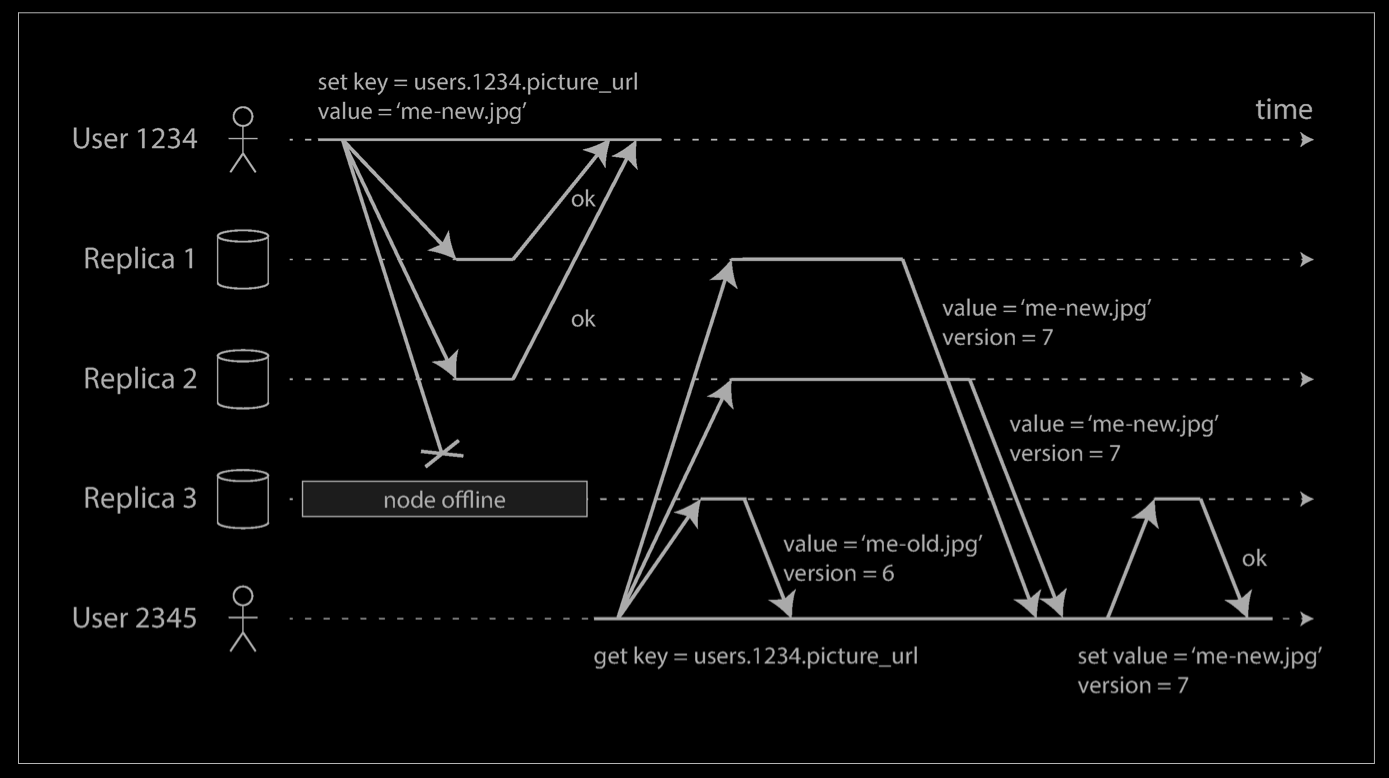Background
Single-leader and multi-leader replication are based on the idea that a client sends a write request to one node (the leader), and the database system takes care of copying that write to the other replicas. A leader determines the order in which writes should be processed, and followers apply the leader’s writes in the same order.
Some data storage systems take a different approach, abandoning the concept of a leader and allowing any replica to directly accept writes from clients. Some of the earliest replicated data systems were leaderless, but the idea was mostly forgotten during the era of dominance of relational databases. It once again became a fashionable architecture for databases after Amazon used it for its in-house Dynamo system. vi Riak, Cassandra, and Voldemort are open source datastores with leaderless replication models inspired by Dynamo, so this kind of database is also known as Dynamo-style.
Writing to the Database When a Node Is Down
Imagine you have a database with three replicas, and one of the replicas is currently unavailable—perhaps it is being rebooted to install a system update. In a leader-based configuration, if you want to continue processing writes, you may need to perform a failover.
On the other hand, in a leaderless configuration, failover does not exist. The diagram below shows what happens: the client (user 1234) sends the write to all three replicas in par‐allel, and the two available replicas accept the write but the unavailable replica misses it. Let’s say that it’s sufficient for two out of three replicas to acknowledge the write: after user 1234 has received two ok responses, we consider the write to be successful. The client simply ignores the fact that one of the replicas missed the write.

Now imagine that the unavailable node comes back online, and clients start reading from it. Any writes that happened while the node was down are missing from that node. Thus, if you read from that node, you may get stale (outdated) values as responses.
To solve that problem, when a client reads from the database, it doesn’t just send its request to one replica: read requests are also sent to several nodes in parallel. The client may get different responses from different nodes; i.e., the up-to-date value from one node and a stale value from another. Version numbers are used to determine which value is newer.
Read repair and anti-entropy
The replication scheme should ensure that eventually all the data is copied to every replica. After an unavailable node comes back online, how does it catch up on the writes that it missed?
Two mechanisms are often used in Dynamo-style datastores:
Read repair
When a client makes a read from several nodes in parallel, it can detect any stale responses. For example, in the example above, user 2345 gets a version 6 value from replica 3 and a version 7 value from replicas 1 and 2. The client sees that replica 3 has a stale value and writes the newer value back to that replica. This approach works well for values that are frequently read.
Anti-entropy process
In addition, some datastores have a background process that constantly looks for differences in the data between replicas and copies any missing data from one replica to another. Unlike the replication log in leader-based replication, this anti-entropy process does not copy writes in any particular order, and there may be a significant delay before data is copied.
Not all systems implement both of these; for example, Voldemort currently does not have an anti-entropy process. Note that without an anti-entropy process, values that are rarely read may be missing from some replicas and thus have reduced durability, because read repair is only performed when a value is read by the application.
Quorums for reading and writing
In the example above, we considered the write to be successful even though it was only processed on two out of three replicas. What if only one out of three replicas accepted the write? How far can we push this?
If we know that every successful write is guaranteed to be present on at least two out of three replicas, that means at most one replica can be stale. Thus, if we read from at least two replicas, we can be sure that at least one of the two is up to date. If the third replica is down or slow to respond, reads can nevertheless continue returning an up-to-date value.
More generally, if there are n replicas, every write must be confirmed by w nodes to be considered successful, and we must query at least r nodes for each read. (In our example, n = 3, w = 2, r = 2.) As long as w + r > n, we expect to get an up-to-date value when reading, because at least one of the r nodes we’re reading from must be up to date. Reads and writes that obey these r and w values are called quorum reads and writes. You can think of r and w as the minimum number of votes required for the read or write to be valid.
Limitations of Quorum Consistency
Reference
- https://en.wikipedia.org/wiki/Replication_(computing)
- Designing Data-Intensive Applications: The Big Ideas Behind Reliable, Scalable, and Maintainable Systems